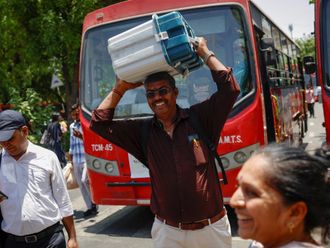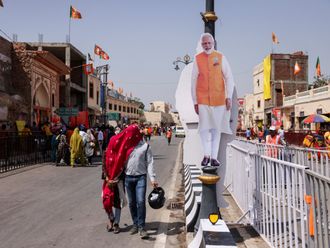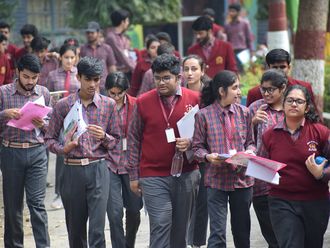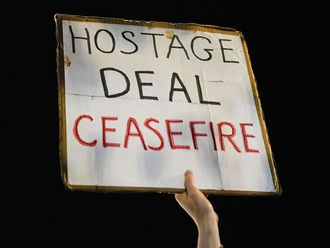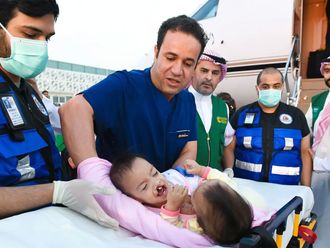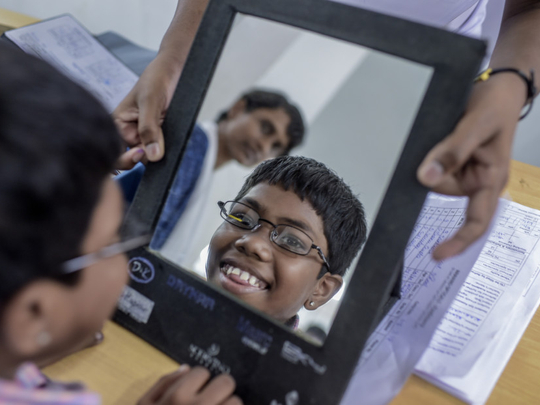
PANIPAT, India
Shivam Kumar’s failing eyesight was manageable at first. To better see the chalkboard, the 12-year-old moved to the front of the classroom, but in time, the indignities piled up.
Increasingly blurry vision forced him to give up flying kites and then cricket, after he was repeatedly whacked by balls he could no longer see. The constant squinting gave him headaches, and he came to dread walking home from school.
“Sometimes I don’t see a motorbike until it’s almost in my face,” he said.
As his grades flagged, so did his dreams of becoming a pilot. “You can’t fly a plane if you’re blind,” he noted glumly.
Simple fix
The fix for Shivam’s declining vision, it turns out, was remarkably simple. He needed glasses.
More than 1 billion people around the world need eyeglasses but don’t have them, researchers say, an affliction long overlooked on lists of public health priorities. Some estimates put that figure closer to 2.5 billion people.
Then there are the tens of millions of children like Shivam across the world whose families cannot afford an eye exam or the prescription eyeglasses that would help them excel in school.
“Many of these kids are classified as poor learners or just dumb and therefore don’t progress at school,” said Kovin Naidoo, global director of Our Children’s Vision, an organisation that provides free or inexpensive eyeglasses across Africa. “That just adds another hurdle to countries struggling to break the cycle of poverty.”
On a recent afternoon, hundreds of children in powder-blue uniforms giddily jostled one another in the dusty courtyard of a high school in Panipat, two hours north of New Delhi. The students, all from poor families, were having their eyesight checked by VisionSpring, a nonprofit group started by Jordan Kassalow, a New York optometrist who helped set up EYElliance, that works with local governments to distribute subsidiszed eyeglasses in Asia and Africa. For most, it was the first time anyone had checked their eyesight.
Shivam, the boy who dreamed of being a pilot, walked away with a pair of purple-framed spectacles donated by Warby Parker, the American eyewear company, which also paid for the screenings.
“Everything is so clear,” Shivam exclaimed as he looked with wonder around the classroom.
Anshu Taneja, VisonSpring’s India director, said that providing that first pair of glasses is pivotal; people who have experienced the benefits of corrected vision will often buy a second pair if their prescription changes or they lose the glasses they have come to depend on.
Ratan Singh, 45, a sharecropper who recently got his first pair of reading glasses, said he could not imagine living without them now. Standing in a field of ripening wheat, he said his inability to see tiny pests on the stalks of his crop had led to decreasing yields. He sheepishly recalled the time he sprayed the wrong insecticide because he couldn’t read the label.
Most adults over 50 need reading glasses - more than 1 billion people in the developing world, according to the International Agency for the Prevention of Blindness — though the vast majority simply accept their creeping disability.
That’s what happened to D. Periyanayakam, 56, a power company employee whose job requires him to read electrical meters. His failing eyesight also made it hard to drive or respond to text messages from customers and co-workers.
“I figured it was a only matter of time before they suspended me,” he said during a visit to a mobile eye clinic run by Aravind Eye Hospital, a nonprofit institution that screened his vision and told him he would soon need cataract surgery.
Periyanayakam returned to work that day with a $2 pair of glasses. He was among 400 people who showed up at a daylong clinic in a high school run by ophthalmologists, lens grinders and vision screeners.
Aravind dispenses 600,000 pairs of glasses each year in India and has expanded its efforts to Nepal, Bangladesh and countries in Africa through local partners.
Good eyesight is a lifeline for truckers
Experts say a significant number of India’s roughly 200,000 traffic deaths each year are tied to poor vision. In a country with a huge number of drivers, among them 9 million truckers, the government agencies that administer licenses are ill-equipped to deal with the problem of declining vision, critics say.
Sightsavers, a British nonprofit that has been treating cataract-related blindness in India since the 1960s, has spent the past two years trying to get glasses to commercial drivers. It operates mobile eye-screening camps at truck stops and tollbooths in 16 cities. A driver who has his eyes examined at a clinic in north India can pick up his glasses 10 days later at a clinic in the far south.
“These men are always on the move and they are pressed for time, so we try to make it as easy as possible for them,” said Ameen, a Sightsaver employee who uses a single name.
On a recent morning, dozens of drivers, many wearing flip-flops and oil-stained trousers, lined up in front of an eye chart taped to the wall of a trucking company in the town of Chapraula, in Uttar Pradesh. Asked why they had waited so long to have their vision checked, some shrugged. Others said they were too busy. A few cited fears they would be fired if an employer discovered that their vision was flawed.
About half the men, it turned out, needed glasses. They included Jagdish Prasad, 55, a father of nine with a deeply lined face who had never had his eyes tested.
“I haven’t had an accident in 35 years,” Prasad exclaimed - but then reluctantly admitted that he has lately been squinting to see whether a traffic light had changed.
Then he gestured to the cavalcade of honking vehicles behind him and told a story. Four days earlier, he said, a mentally ill man had been lying on the edge of the road, forcing drivers to swerve to avoid him. One of those vehicles, a truck not unlike his own, tried to avoid the man but ended up killing two students who were crossing the road on their way to school. The next day, the mentally ill man was also struck and killed, Prasad said.
He paused and then considered the piece of paper in his hand. It contained the prescription for his first pair of glasses. Prasad hesitated and then gently placed it in his pocket.
Where is all the money going?
In an era when millions of people still perish from preventable or treatable illness, many major donors devote their largess to combating killers like AIDS, malaria and tuberculosis.
In 2015, only $37 million was spent on delivering eyeglasses to people in the developing world, less than one percent of resources devoted to global health issues, according to EYElliance, a nonprofit group trying to raise money and bring attention to the problem of uncorrected vision.
$200 billion
The World Health Organisation has estimated eye problems cost the global economy more than $200 billion annually in lost productivity.
“Lack of access to eye care prevents billions of people around the world from achieving their potential, and is a major barrier to economic and human progress,” said Madeleine K. Albright, the former secretary of state who is also involved in the group.
It comes cheap, as you can see
Factories in Thailand, China and the Philippines can manufacture so-called readers for less than 50 cents a pair; prescription glasses that correct nearsightedness can be produced for $1.50.
In rural India, glasses are seen as a sign of infirmity, and in many places, a hindrance for young women seeking to get married.


